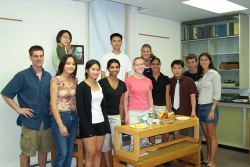
 |
CHANGE DETECTION BLINDNESS IN MOVING VISUAL SCENES |
|
ABSTRACT Experience shows that an individual, after viewing a rich visual scene, is left with a detailed perceptual trace of the properties and locations of objects in that scene. At the same time, there are many classic instances of unnoticed editing mistakes in movies. Even though some changes within the clip are obvious, the observer surprisingly cannot detect them. When Dorothy meets the scarecrow in "The Wizard of Oz," for example, her pigtails are at first short (above her shoulders) but become longer (below her shoulders) across scene cuts. Her hair length, as a matter of fact, changes five times in one scene, yet the viewer typically fails to notice these alterations. It has been suggested that these changes may go unnoticed because the viewers' attention is directed towards the plot, scenery, and dialogue of the film. They do not expect these changes to occur, especially since the modifications to Dorothy's pigtails are small and subtle. To study this pattern of lack of perception and attention, we created a video with both obvious and minor changes across scenes. In addition, we manipulated whether or not viewers expected changes to occur by having an instructed and non-instructed group. Participants of the experiment watched the clip and reported the changes that they observed. Results indicated that attention to changes did increased the viewers' ability to detect them. Furthermore, it was found that changes to more prominent objects in the visual scene were more noticeable than others. . |
Journal
Presentation
Team Picture
Back to Journal Title Page |